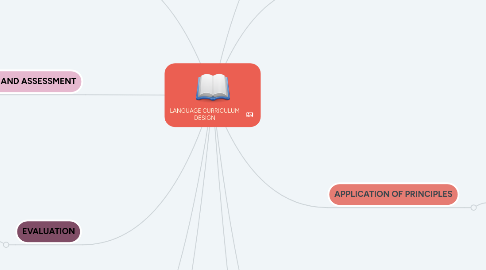
1. CONTENT AND SEQUENCING
1.1. A way to provide a systematic and well- researched basis for a course is make to use frequent list
1.1.1. Frequency-based lvocabulary lists
1.1.2. Frequency list of verb forms and verb groups
1.1.3. List of fuctions and topics
1.1.4. Lists of subskilss and strategies
1.1.5. List of tasks, topics and themes.
2. MONITORING AND ASSESSMENT
2.1. ASESS
2.1.1. Proficiency Test
2.1.2. Achievement Test
2.1.3. Larger achievement
2.1.4. Placement test
2.2. MONITOR
2.2.1. Checklist
2.2.2. Report forms
2.2.3. Learning logs
3. EVALUATION
3.1. Planning and Running of the course
3.1.1. Examine the environment
3.1.2. Assess needs
3.1.3. Decide on principles
3.1.4. Set goals, and choose and sequence content
3.1.5. Design the lesson format
3.1.6. Include assesment procedures
3.1.7. Evaluate the course
4. ENVIRONMENT ANALYSIS
4.1. FACTORS
4.1.1. Learners
4.1.2. Teachers
4.1.3. Situation
5. BIBLIOGRAPHY
5.1. Macalister, J., & Nation, I. S. P. (2009). Language curriculum design. Routledge.
6. GOALS
6.1. Is essential to decide why a course is being taugh and what the leerners need to get from it.
6.1.1. EXAMPLES
6.1.1.1. to encourage students to exploit all elements of the language
6.1.1.2. sustain interest and motivation
6.1.1.3. help students understand and formulate gramatical rules
7. FORMAT AND PRESENTATION
7.1. USE
7.1.1. suitable teaching
7.1.1.1. unpredictable
7.1.2. procedures
7.1.2.1. set format
8. APPLICATION OF PRINCIPLES
8.1. Decide how learning can be encouraged
8.1.1. CONTENT AND SEQUENCING
8.1.1.1. Frequency
8.1.1.2. Strategies and autonommy
8.1.1.3. Spacial retrieval
8.1.1.4. Language System
8.1.1.5. Keep moving forward
8.1.1.6. Teachability
8.1.1.7. Interference
8.1.2. FORMAT AND PRESENTATION
8.1.2.1. Motivation
8.1.2.2. Four strands
8.1.2.3. Comprehensible input
8.1.2.4. Fluency
8.1.2.5. Output
8.1.2.6. Deliberate learning
8.1.2.7. Time on task
8.1.2.8. Depth of processing
8.1.2.9. Integrate motivation
8.1.2.10. Learning style
8.1.3. MONITORING AND ASSESSMENT
8.1.3.1. Ongoing needs and environment analysis
8.1.3.2. Feedback
9. NEEDS ANALYSIS
9.1. The aim is to discover
9.1.1. What needs to be learned?
9.1.1.1. Necessities
9.1.1.1.1. What is necessary in the learners use of language?
9.1.1.2. Lacks
9.1.1.2.1. What do the learners lack?
9.1.2. What learners want to learn?
9.1.2.1. Wants
9.1.2.1.1. What do the learners wish to learn?
